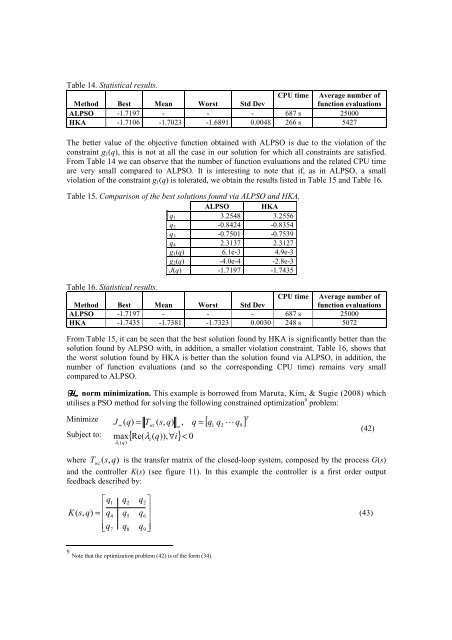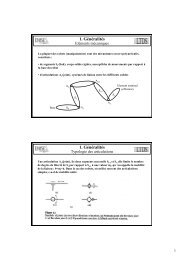q - Rosario Toscano - Free
q - Rosario Toscano - Free
q - Rosario Toscano - Free
Create successful ePaper yourself
Turn your PDF publications into a flip-book with our unique Google optimized e-Paper software.
Table 14. Statistical results.<br />
CPU time Average number of<br />
Method Best Mean Worst Std Dev<br />
function evaluations<br />
ALPSO -1.7197 - - - 687 s 25000<br />
HKA -1.7106 -1.7023 -1.6891 0.0048 266 s 5427<br />
The better value of the objective function obtained with ALPSO is due to the violation of the<br />
constraint g1(q), this is not at all the case in our solution for which all constraints are satisfied.<br />
From Table 14 we can observe that the number of function evaluations and the related CPU time<br />
are very small compared to ALPSO. It is interesting to note that if, as in ALPSO, a small<br />
violation of the constraint g1(q) is tolerated, we obtain the results listed in Table 15 and Table 16.<br />
Table 15. Comparison of the best solutions found via ALPSO and HKA.<br />
ALPSO HKA<br />
q1 3.2548 3.2556<br />
q2 -0.8424 -0.8354<br />
q3 -0.7501 -0.7539<br />
q4 2.3137 2.3127<br />
g1(q) 6.1e-3 4.9e-3<br />
g2(q) -4.0e-4 -2.8e-3<br />
J(q) -1.7197 -1.7435<br />
Table 16. Statistical results.<br />
CPU time Average number of<br />
Method Best Mean Worst Std Dev<br />
function evaluations<br />
ALPSO -1.7197 - - - 687 s 25000<br />
HKA -1.7435 -1.7381 -1.7323 0.0030 248 s 5072<br />
From Table 15, it can be seen that the best solution found by HKA is significantly better than the<br />
solution found by ALPSO with, in addition, a smaller violation constraint. Table 16, shows that<br />
the worst solution found by HKA is better than the solution found via ALPSO, in addition, the<br />
number of function evaluations (and so the corresponding CPU time) remains very small<br />
compared to ALPSO.<br />
HHHH∞ norm minimization. This example is borrowed from Maruta, Kim, & Sugie (2008) which<br />
utilises a PSO method for solving the following constrained optimization 9 problem:<br />
Minimize [ ] T<br />
J ∞ ( q)<br />
= Twz<br />
( s,<br />
q)<br />
, ∞ q = q1<br />
q2<br />
L q9<br />
max Re( λi<br />
( q)),<br />
∀i<br />
λi<br />
( q)<br />
<<br />
Subject to: { } 0<br />
where Twz ( s,<br />
q)<br />
is the transfer matrix of the closed-loop system, composed by the process G(s)<br />
and the controller K(s) (see figure 11). In this example the controller is a first order output<br />
feedback described by:<br />
⎡q1<br />
q2<br />
q2<br />
⎤<br />
K ( s,<br />
q)<br />
=<br />
⎢ ⎥<br />
⎢<br />
q4<br />
q5<br />
q6<br />
(43)<br />
⎥<br />
⎢⎣<br />
q ⎥<br />
7 q8<br />
q9<br />
⎦<br />
9 Note that the optimization problem (42) is of the form (34).<br />
(42)



